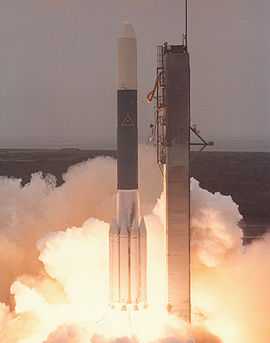Delta 3000
 Launch of SolarMax on a Delta 3910 7.2-J 6900.1 | |
| Function | Expendable launch system |
|---|---|
| Country of origin | |
| Launch history | |
| Status | Retired |
| Launch sites | Canaveral LC-17 Vandenberg SLC-2W |
| Total launches | 35 |
| Successes | 32 |
| Partial failures | 1 |
| First flight | 13 December 1975 |
| Last flight | 24 March 1989 |
The Delta 3000 series was an American expendable launch system which was used to conduct thirty five orbital launches between 1975 and 1989. It was a member of the Delta family of rockets. Several variants existed, which were differentiated by a four digit numerical code.
The first stage was the RS-27 powered Extended Long Tank Thor, first flown on the 2000-series. Three or nine Castor-4 solid rocket boosters were attached to increase thrust at lift-off, replacing the less powerful Castor-2 boosters used on earlier models. Two second stages were available; the Delta-P, which had been flown on the Delta 1000 and 2000 series, or the Delta-K, an uprated version with the Aerojet engine. Some launches used a three-stage configuration in order to reach higher orbits. A Star-37D, Star-37E, or Star-48B PAM-D could be used as an upper stage. Launches with PAM-D upper stages were designated Delta 3XX0 PAM-D, rather than assigning a code to the upper stage for use in the four-digit sequence. From the 4000-series onwards, the PAM-D received the upper stage code "5", however this was not applied retrospectively to 3000-series rockets, which were still in service at the time.
The Delta 3000 was launched from Space Launch Complex 2W at Vandenberg AFB and Launch Complex 17A and B at Cape Canaveral. Of the 35 launches, there were two complete and one partial failure. The first, Vehicle 134 lifted from LC-17A at Cape Canaveral on September 13, 1977 with a European OTS communications satellite and exploded less than a minute into the flight when one of the solid rocket motor casings ruptured. There had been an upper stage failure of a Delta 2000 series in April and three weeks later, an Atlas-Centaur exploded 55 seconds after liftoff. NASA was particularly vexed by the string of accidents in 1977 because they had had a perfect run the year before (16 launches in 1976 without a failure). While this record (three failures out of 16 NASA launches during 1977) would have been acceptable in the 1960s, it was not welcomed at all in the late 1970s after the early "Wild West" days of the space program had passed and the hardware was supposed to be mature.
The second Delta 3000 failure, Vehicle 150, was launched on December 7, 1979 but its Satcom communications satellite remained trapped in low earth orbit when the third stage failed to ignite. The third, Vehicle 178, launched on May 3, 1986 with a GOES weather satellite. This was televised on CNN to mark NASA's first launch since the Challenger Disaster four months earlier, but proved to be a serious embarrassment to the program. The Delta performed normally until T+71 seconds when the main engine abruptly shut off. With no attitude control, the launch vehicle began tumbling violently. The shroud, payload, and third stage were ripped away followed several seconds later by Range Safety issuing the destruct command. It was the first time an electrical failure had occurred in a Delta since its introduction in 1960. Investigators concluded that two voltage spikes in the power system (which was also an old design not modified or updated since 1960) had caused the engine valves to snap shut, immediately terminating all thrust. As the solid rocket motors had fixed nozzles with no gimballing ability, the booster became completely uncontrollable without the main engine. Delta 150 was the first failed launch since 134 nine years earlier and marked the end of 42 consecutive flights without a failure, a record for the US space program.
During the first half of the 1980s, the rate of Delta launches drastically declined due to the space shuttle taking a large part of its missions. Orders for the booster slowed to a trickle and McDonnell-Douglas came close to completely shutting down production. 1985 was the first year since the Delta family's introduction in 1960 that no launches took place, but the Challenger Disaster brought about a renewed need for disposable launch vehicles and orders soon picked up again. While only a handful of Delta launches took place in 1986-88, nine flew in 1989 and the 1990s would see a busy schedule most years except 1994-95 (seven launches during those two years).
References
- Wade, Mark. "Delta". Encyclopedia Astronautica. Retrieved 2009-02-15.
- Krebs, Gunter. "Thor family". Gunter's Space Page. Retrieved 2009-02-15.
| ||||||||||||||
| ||||||||||||||||||
| |||||||||||||||||||||||||||||||||||||||||||||||||||||||||||||||||||||||||||||||||||||||||||||
